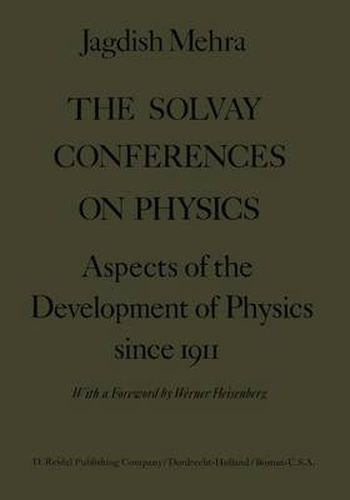Readings Newsletter
Become a Readings Member to make your shopping experience even easier.
Sign in or sign up for free!
You’re not far away from qualifying for FREE standard shipping within Australia
You’ve qualified for FREE standard shipping within Australia
The cart is loading…






This title is printed to order. This book may have been self-published. If so, we cannot guarantee the quality of the content. In the main most books will have gone through the editing process however some may not. We therefore suggest that you be aware of this before ordering this book. If in doubt check either the author or publisher’s details as we are unable to accept any returns unless they are faulty. Please contact us if you have any questions.
Jagdish Mehra’s historical account of the Solvay Conferences from 1911 to 1973 demonstrates not only the great influence which these conferences have had on the development of modern physics, but it also shows clearly how far-sighted and well planned were the intentions of Ernest Solvay when he took the initiative for organizing a new type of international conferences. In contrast to the conventional meetings in which reports are given on the successful solution of scientific problems, the Solvay Conferences were conceived to help directly in solving specific problems of unusual difficulty. The importance of the quantum structure of Nature had become well under stood already by 1911, but at that time there was no hope for an answer to the ex tremely difficult new questions posed by the atomic phenomena. The new conferences should therefore be devoted primarily to thorough discussions of such problems be tween a small number of the most competent physicists, and Ernest Solvay was guided by the hope that the discussions would eventually lead to a real and substantial progress. The earliest Solvay Conferences which I attended were those of 1927, 1930 and 1933, and they served this purpose extremely well. In 1926 the mathematical formalism of quantum-and wave-mechanics approached its final shape, but the interpretation was still controversial. Schrodinger hoped that his matter waves could be considered as waves in three-dimensional space and time, and that the discontinuous feature of quantum ‘jumps’ could be avoided thereby.
$9.00 standard shipping within Australia
FREE standard shipping within Australia for orders over $100.00
Express & International shipping calculated at checkout
This title is printed to order. This book may have been self-published. If so, we cannot guarantee the quality of the content. In the main most books will have gone through the editing process however some may not. We therefore suggest that you be aware of this before ordering this book. If in doubt check either the author or publisher’s details as we are unable to accept any returns unless they are faulty. Please contact us if you have any questions.
Jagdish Mehra’s historical account of the Solvay Conferences from 1911 to 1973 demonstrates not only the great influence which these conferences have had on the development of modern physics, but it also shows clearly how far-sighted and well planned were the intentions of Ernest Solvay when he took the initiative for organizing a new type of international conferences. In contrast to the conventional meetings in which reports are given on the successful solution of scientific problems, the Solvay Conferences were conceived to help directly in solving specific problems of unusual difficulty. The importance of the quantum structure of Nature had become well under stood already by 1911, but at that time there was no hope for an answer to the ex tremely difficult new questions posed by the atomic phenomena. The new conferences should therefore be devoted primarily to thorough discussions of such problems be tween a small number of the most competent physicists, and Ernest Solvay was guided by the hope that the discussions would eventually lead to a real and substantial progress. The earliest Solvay Conferences which I attended were those of 1927, 1930 and 1933, and they served this purpose extremely well. In 1926 the mathematical formalism of quantum-and wave-mechanics approached its final shape, but the interpretation was still controversial. Schrodinger hoped that his matter waves could be considered as waves in three-dimensional space and time, and that the discontinuous feature of quantum ‘jumps’ could be avoided thereby.